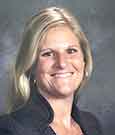 |
Woodland Primary
Students Talk about Numbers
Jennifer Statzer, Assistant Principal
Woodland Heights Elementary
Ohio’s New Learning Standards for Mathematics call for students to be
problem solvers. One way teachers at Woodland are answer this call is
by teaching their students to be independent problem solvers through
the use of Number Talks. This teaching resource was chosen because many
teachers recognize the need for all students to be fluent with math
strategies, they also recognize that not every child thinks about math
in the same way. Teachers are responding to the different mathematical
needs of the students in the classroom by implementing this resource to
aid in student growth.
Number Talks is a 5 to 15 minute problem solving lesson that helps
students make sense of mathematics, develop efficient computation
strategies, communicate mathematically and provides opportunities for
students to reason and prove solutions. Mental math is a key part of
number talks because it encourages students to build on number
connections to solve problems instead of relying on memorized
procedures. One of the purposes of a number talk is for the students to
focus on number connections and use these connections to solve
problems. Communication is also a key component. Throughout a
number talk students may be asked to share their strategies and respond
to other students’ strategies as well. This communication is an
important way to establish productive conversation around mathematics.
Students use dot images, rekenreks, five and ten frames and strategies
for solving to build their knowledge of how numbers work together. Each
year these strategies build on each other in order to help the students
develop mental computation skills. Questions such as, “How did you
solve that” and “Can this problem be solved a different way?” help
students communicate their mathematical thinking. This allows the
teacher to understand how the students are making sense of mathematics
and offer support as needed.
It is so exciting to hear students talk about their thinking and to
learn from each other. Through the use of these standards based,
problem solving strategies, teachers are fostering little
mathematicians at Woodland.
|
|
|
|

